Software-Defined Radio-Based Internet of Things Communication Systems: An Application for the DASH7 Alliance Protocol †
Abstract
1. Introduction
2. LPWAN Technologies
2.1. LoRaWAN
2.2. Sigfox
2.3. NB-IoT
2.4. DASH7
3. SDR Technology
3.1. SDR Architecture
3.1.1. SDR Transmission Mode
3.1.2. SDR Receiving Mode
3.2. GNU Radio
3.3. In-Phase and Quadrature Data
4. DASH7 Communication System
4.1. Air Interface
4.1.1. RF Channels
4.1.2. Channel Classes
4.1.3. DASH7 Modulation Scheme
4.1.4. Gaussian Minimum-Shift Keying
4.2. Packet Structure
5. DASH7 Communication System Implementation
5.1. The Transmitting Process
5.1.1. Data Formatting
5.1.2. Symbols to Waveform Conversion
5.1.3. Baseband Modulation
5.2. The Receiving Process
5.2.1. Reception
5.2.2. Demodulation
- Extracting the phase of the baseband signal using a Complex to Arg block:where k is the digitized time index, and is a constant arbitrary phase due to the phase difference between the transmitter and the receiver.
- Taking the derivative ofwhere h is the modulation index and is equal to the following:In order to further decode the packet, the following are required:
- Time synchronisation and bit decimation must be performed.
- Payload detection based on the sync word bits.
- To decode the payload data, further data de-whitening and the optional FEC decoding are required.
5.2.3. Time Synchronisation
5.2.4. Decoding
6. Experimental Setup
Measurement Environments
7. Results and Discussion
8. Conclusions
Author Contributions
Funding
Institutional Review Board Statement
Informed Consent Statement
Data Availability Statement
Conflicts of Interest
Appendix A. DASH7 CRC16 Validation
| 111 11001100 000 | |
| 101 1 | divisor (4 bits) = |
| 010 01001100 000 ← result |
| 1 | 1 | 1 | 1 | 1 | 1 | 0 | 0 | 1 | 1 | 0 | 0 | 0 | 0 | 0 |
| 1 | 0 | 1 | 1 | |||||||||||
| 2 | 0 | 1 | 0 | 0 | 1 | 0 | 0 | 1 | 1 | 0 | 0 | 0 | 0 | 0 |
| 1 | 0 | 1 | 1 | |||||||||||
| 3 | 0 | 0 | 0 | 1 | 0 | 0 | 0 | 1 | 1 | 0 | 0 | 0 | 0 | 0 |
| 1 | 0 | 1 | 1 | |||||||||||
| 4 | 0 | 0 | 0 | 0 | 0 | 1 | 1 | 1 | 1 | 0 | 0 | 0 | 0 | 0 |
| 1 | 0 | 1 | 1 | |||||||||||
| 5 | 0 | 0 | 0 | 0 | 0 | 0 | 1 | 0 | 0 | 0 | 0 | 0 | 0 | 0 |
| 1 | 0 | 1 | 1 | |||||||||||
| 6 | 0 | 0 | 0 | 0 | 0 | 0 | 0 | 0 | 1 | 1 | 0 | 0 | 0 | 0 |
| 1 | 0 | 1 | 1 | |||||||||||
| 7 | 0 | 0 | 0 | 0 | 0 | 0 | 0 | 0 | 0 | 1 | 1 | 1 | 0 | 0 |
| 1 | 0 | 1 | 1 | |||||||||||
| 8 | 0 | 0 | 0 | 0 | 0 | 0 | 0 | 0 | 0 | 0 | 1 | 0 | 1 | 0 |
| 1 | 0 | 1 | 1 | |||||||||||
| 9 | 0 | 0 | 0 | 0 | 0 | 0 | 0 | 0 | 0 | 0 | 0 | 0 | 0 | 1 |
| 1 | 1 | 1 | 1 | 1 | 1 | 0 | 0 | 1 | 1 | 0 | 0 | 0 | 0 | 1 |
| 1 | 0 | 1 | 1 | |||||||||||
| 2 | 0 | 1 | 0 | 0 | 1 | 0 | 0 | 1 | 1 | 0 | 0 | 0 | 0 | 1 |
| 1 | 0 | 1 | 1 | |||||||||||
| 3 | 0 | 0 | 0 | 1 | 0 | 0 | 0 | 1 | 1 | 0 | 0 | 0 | 0 | 1 |
| 1 | 0 | 1 | 1 | |||||||||||
| 4 | 0 | 0 | 0 | 0 | 0 | 1 | 1 | 1 | 1 | 0 | 0 | 0 | 0 | 1 |
| 1 | 0 | 1 | 1 | |||||||||||
| 5 | 0 | 0 | 0 | 0 | 0 | 0 | 1 | 0 | 0 | 0 | 0 | 0 | 0 | 1 |
| 1 | 0 | 1 | 1 | |||||||||||
| 6 | 0 | 0 | 0 | 0 | 0 | 0 | 0 | 0 | 1 | 1 | 0 | 0 | 0 | 1 |
| 1 | 0 | 1 | 1 | |||||||||||
| 7 | 0 | 0 | 0 | 0 | 0 | 0 | 0 | 0 | 0 | 1 | 1 | 1 | 0 | 1 |
| 1 | 0 | 1 | 1 | |||||||||||
| 8 | 0 | 0 | 0 | 0 | 0 | 0 | 0 | 0 | 0 | 0 | 1 | 0 | 1 | 1 |
| 1 | 0 | 1 | 1 | |||||||||||
| 9 | 0 | 0 | 0 | 0 | 0 | 0 | 0 | 0 | 0 | 0 | 0 | 0 | 0 | 0 |
Appendix B. Forward Error Correction
| Input [4 B] | 0x03 | 0x01 | 0x02 | 0x03 | ||||
| Appended CRC [6 B] | 0x03 | 0x01 | 0x02 | 0x03 | 0x7E | 0x2D | ||
| Appended Trellis terminator [8 B] | 0x03 | 0x01 | 0x02 | 0x03 | 0x7E | 0x2D | 0x0B | 0x0B |
| FEC encoder output [16 B] | 00 | 0E | 8C | 03 | 7C | 0D | F0 | 0E | B5 | A9 | 3D | 1B | BC | D1 | 8C | D1 |
| Interleaver output [16 B] | C8 | 3C | 00 | 20 | 84 | CF | 33 | 31 | D5 | B9 | 7B | 0A | 44 | 33 | 37 | EE |



Appendix C. PN9 Coding
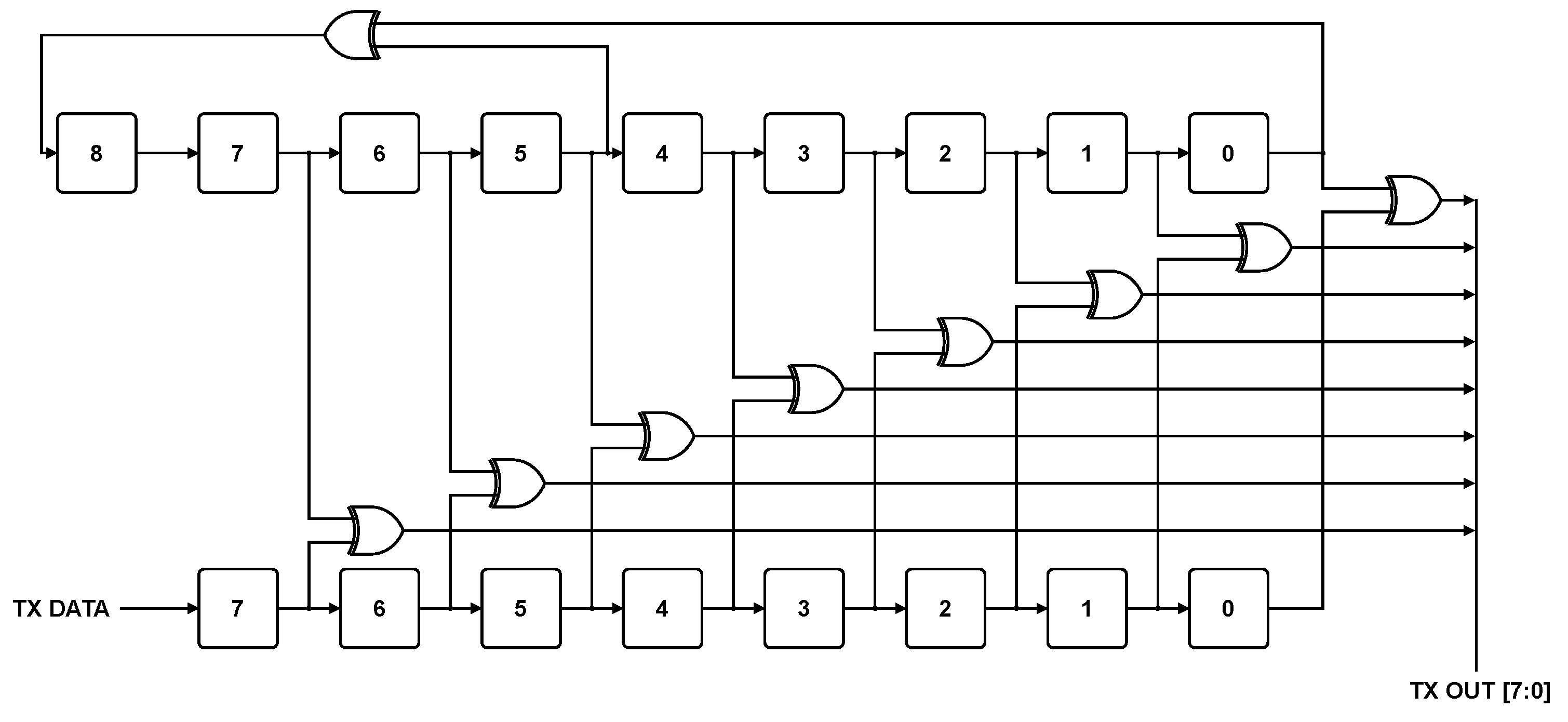
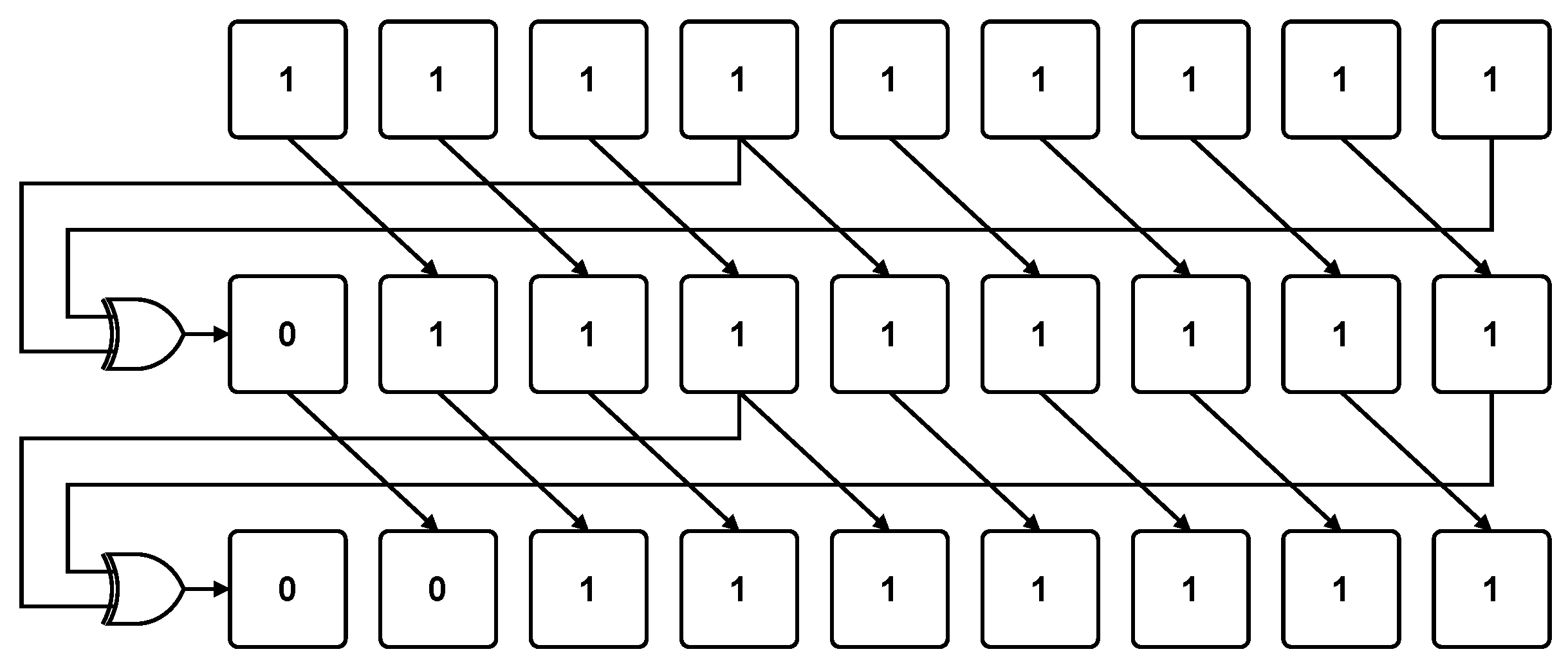
- Suppose the (unwhitened) data sequence to be transmitted starts out as follows (these would be the bytes, for example, if a packet with a packet length byte of ten were transmitted, and the data were 0x00, 0x01,...): /0000 1010/0000 0000/0000 0001/0000 0010/... Remember that the values to XOR with the data are the eight LSBs of the PN9 sequence if every eighth value is used:
- 1,1,1,1,1,1,1,1,1 *** Eight LSBs are 1111 1111
- 0,1,1,1,1,1,1,1,1
- 0,0,1,1,1,1,1,1,1
- 0,0,0,1,1,1,1,1,1
- 0,0,0,0,1,1,1,1,1
- 1,0,0,0,0,1,1,1,1
- 1,1,0,0,0,0,1,1,1
- 1,1,1,0,0,0,0,1,1
- 1,1,1,1,0,0,0,0,1 *** Eight LSBs are 1110 0001
- 0,1,1,1,1,0,0,0,0
- 1,0,1,1,1,1,0,0,0
- 1,1,0,1,1,1,1,0,0
- 1,1,1,0,1,1,1,1,0
- 0,1,1,1,0,1,1,1,1
- 0,0,1,1,1,0,1,1,1
- 0,0,0,1,1,1,0,1,1
- 0,0,0,0,1,1,1,0,1 *** Eight LSBs are 0001 1101
- 1,0,0,0,0,1,1,1,0
- 0,1,0,0,0,0,1,1,1
- 1,0,1,0,0,0,0,1,1
- 1,1,0,1,0,0,0,0,1
- 0,1,1,0,1,0,0,0,0
- 0,0,1,1,0,1,0,0,0
- 1,0,0,1,1,0,1,0,0
- 1,1,0,0,1,1,0,1,0 *** Eight LSBs are 10011010
- 0,1,1,0,0,1,1,0,1
- So, the values to XOR with the data are as follows:
- / 1111 1111/1110 0001/0001 1101/1001 1010/
- Taking the exclusive-OR of these two sequences gives the data to be transmitted:
- Data: /0000 1010/0000 0000/0000 0001/0000 0010 ...
- PN9: /1111 1111/1110 0001/0001 1101/1001 1010/...
- Result:/1111 0101/1110 0001/0001 1100/1001 1000 /...
- When received, the resultant data are XOR’d with the same PN9-derived sequence, resulting in the originally transmitted data.
- Received: /1111 0101/1110 0001/0001 1100/1001 1000 /...
- PN9: /1111 1111/1110 0001/0001 1101/1001 1010/...
- Data: /0000 1010/0000 0000/0000 0001/0000 0010/...
References
- Zanella, A.; Bui, N.; Castellani, A.; Vangelista, L.; Zorzi, M. Internet of Things for Smart Cities. IEEE Internet Things J. 2014, 1, 22–32. [Google Scholar] [CrossRef]
- Centenaro, M.; Vangelista, L.; Zanella, A.; Zorzi, M. Long-range Communications in Unlicensed Bands: The Rising Stars in the IoT and Smart City Scenarios. IEEE Wirel. Commun. 2016, 23, 60–67. [Google Scholar] [CrossRef]
- Bni Lam, N.H. Angle of Arrival Estimation for Low Power and Long Range Communication Networks. Ph.D. Thesis, University of Antwerp, Faculty of Applied Engineering, Antwerp, Belgium, 2021. Available online: https://repository.uantwerpen.be/docstore/d:irua:6256 (accessed on 24 December 2024).
- BniLam, N.; Janssens, R.; Steckel, J.; Weyn, M. AoA Estimates for LPWAN Technologies: Indoor Experimental Analysis. In Proceedings of the 2021 15th European Conference on Antennas and Propagation (EuCAP), Düsseldorf, Germany, 22–26 March 2021; pp. 1–5. [Google Scholar] [CrossRef]
- BniLam, N.; Steckel, J.; Weyn, M. Synchronization of Multiple Independent Subarray Antennas: An Application for Angle of Arrival Estimation. IEEE Trans. Antennas Propag. 2019, 67, 1223–1232. [Google Scholar] [CrossRef]
- BniLam, N.; Joosens, D.; Steckel, J.; Weyn, M. Low Cost AoA Unit for IoT Applications. In Proceedings of the 2019 13th European Conference on Antennas and Propagation (EuCAP), Krakow, Poland, 31 March–5 April 2019; pp. 1–5. [Google Scholar]
- BniLam, N.; Ergeerts, G.; Subotic, D.; Steckel, J.; Weyn, M. Adaptive probabilistic model using angle of arrival estimation for IoT indoor localization. In Proceedings of the 2017 International Conference on Indoor Positioning and Indoor Navigation (IPIN), Sapporo, Japan, 18–21 September 2017; pp. 1–7. [Google Scholar] [CrossRef]
- DASH7 Alliance. Available online: http://www.dash7-alliance.org (accessed on 10 September 2024).
- Sub-IoT. Available online: https://sub-iot.github.io/Sub-IoT-Stack (accessed on 10 September 2024).
- Mekki, K.; Bajic, E.; Chaxel, F.; Meyer, F. A Comparative Study of LPWAN Technologies for Large-scale IoT Deployment. ICT Express 2019, 5, 1–7. [Google Scholar] [CrossRef]
- Semtech. Available online: https://www.semtech.com (accessed on 10 September 2024).
- Janssen, T.; BniLam, N.; Aernouts, M.; Berkvens, R.; Weyn, M. LoRa 2.4 GHz communication link and range. Sensors 2020, 20, 4366. [Google Scholar] [CrossRef] [PubMed]
- BniLam, N.; Nasser, S.; Weyn, M. Angle of Arrival Estimation System for LoRa Technology based on Phase Detectors. In Proceedings of the 2022 16th European Conference on Antennas and Propagation (EuCAP), Madrid, Spain, 27 March–1 April 2022; pp. 1–5. [Google Scholar] [CrossRef]
- Adefemi Alimi, K.O.; Ouahada, K.; Abu-Mahfouz, A.M.; Rimer, S. A Survey on the Security of Low Power Wide Area Networks: Threats, Challenges, and Potential Solutions. Sensors 2020, 20, 5800. [Google Scholar] [CrossRef] [PubMed]
- BniLam, N.; Joosens, D.; Aernouts, M.; Steckel, J.; Weyn, M. LoRay: AoA Estimation System for Long Range Communication Networks. IEEE Trans. Wirel. Commun. 2021, 20, 2005–2018. [Google Scholar] [CrossRef]
- Wang, Y.P.E.; Lin, X.; Adhikary, A.; Grovlen, A.; Sui, Y.; Blankenship, Y.; Bergman, J.; Razaghi, H.S. A Primer on 3GPP Narrowband Internet of Things. IEEE Commun. Mag. 2017, 55, 117–123. [Google Scholar] [CrossRef]
- Bembe, M.; Abu-Mahfouz, A.; Masonta, M.; Ngqondi, T. A survey on low-power wide area networks for IoT applications. Telecommun. Syst. 2019, 71, 249–274. [Google Scholar] [CrossRef]
- Bnilam, N.; Joosens, D.; Berkvens, R.; Steckel, J.; Weyn, M. AoA-Based Localization System Using a Single IoT Gateway: An Application for Smart Pedestrian Crossing. IEEE Access 2021, 9, 13532–13541. [Google Scholar] [CrossRef]
- Price, N.D.; Zawodniok, M.J.; Guardiola, I.G. Transceivers as a Resource: Scheduling Time and Bandwidth in Software-Defined Radio. IEEE Access 2020, 8, 132603–132613. [Google Scholar] [CrossRef]
- GNU Radio. Available online: https://www.gnuradio.org/ (accessed on 10 September 2024).
- DASH7 Alliance. DASH7 Alliance Protocol Specification v1.2. Available online: https://www.dash7-alliance.org/download-specification/ (accessed on 10 September 2024).
- Norair, J. Introduction to DASH7 Technologies, 1st ed.; 2009; Available online: https://www.rfidjournal.com/wp-content/uploads/2019/07/269.pdf (accessed on 24 December 2024).
- Singh, R.K.; Puluckul, P.P.; Berkvens, R.; Weyn, M. Energy Consumption Analysis of LPWAN Technologies and Lifetime Estimation for IoT Application. Sensors 2020, 20, 4794. [Google Scholar] [CrossRef] [PubMed]
- Sklar, B. Digital Communications: Fundamentals & Applications, 2nd ed.; Prentice Hall: Upper Saddle River, NJ, USA, 2001. [Google Scholar]
- Lyons, R. Understanding Digital Signal Processing, 3rd ed.; Prentice Hall: Upper Saddle River, NJ, USA, 2011. [Google Scholar]
- Proakis, J.; Salehi, M. Digital Communications, 5th ed.; McGraw-Hill: New York, NY, USA, 2008. [Google Scholar]
- Mueller, K.; Muller, M. Timing Recovery in Digital Synchronous Data Receivers. IEEE Trans. Commun. 1976, 24, 516–531. [Google Scholar] [CrossRef]
- Joosens, D.; BniLam, N.; Weyn, M.; Berkvens, R. SDR-Based IoT Communication Systems: An Application for the DASH7 Alliance Protocol. Dataset Zenodo. 2024. Available online: https://zenodo.org/records/10961311 (accessed on 10 September 2024).
- Joosens, D.; BniLam, N.; Berkvens, R.; Weyn, M. Implementation of a Multi-Channel DASH7 IoT Communication System for Packet Investigation and Validation. In Proceedings of the GNU Radio Conference 2024, Knoxville, TN, USA, 16–20 September 2024. [Google Scholar]
- Semtech. SX1276/77/78/79–137 MHz to 1020 MHz Low Power Long Range Transceiver; Semtech: Camarillo, CA, USA, 2020; Available online: https://semtech.my.salesforce.com/sfc/p/#E0000000JelG/a/2R0000001Rbr/6EfVZUorrpoKFfvaF_Fkpgp5kzjiNyiAbqcpqh9qSjE (accessed on 10 September 2024).
- Weyn, M.; Ergeerts, G.; Wante, L.; Vercauteren, C.; Hellinckx, P. Survey of the DASH7 Alliance Protocol for 433 MHz Wireless Sensor Communication. Int. J. Distrib. Sens. Netw. 2013, 9, 870430. [Google Scholar] [CrossRef]
- Hoel, R. Design Note DN504: FEC Implementation; Texas Instruments: Dallas, TX, USA, 2007; Rev. SWRA113A; Available online: http://www.ti.com/lit/an/swra113a/swra113a.pdf (accessed on 10 September 2024).
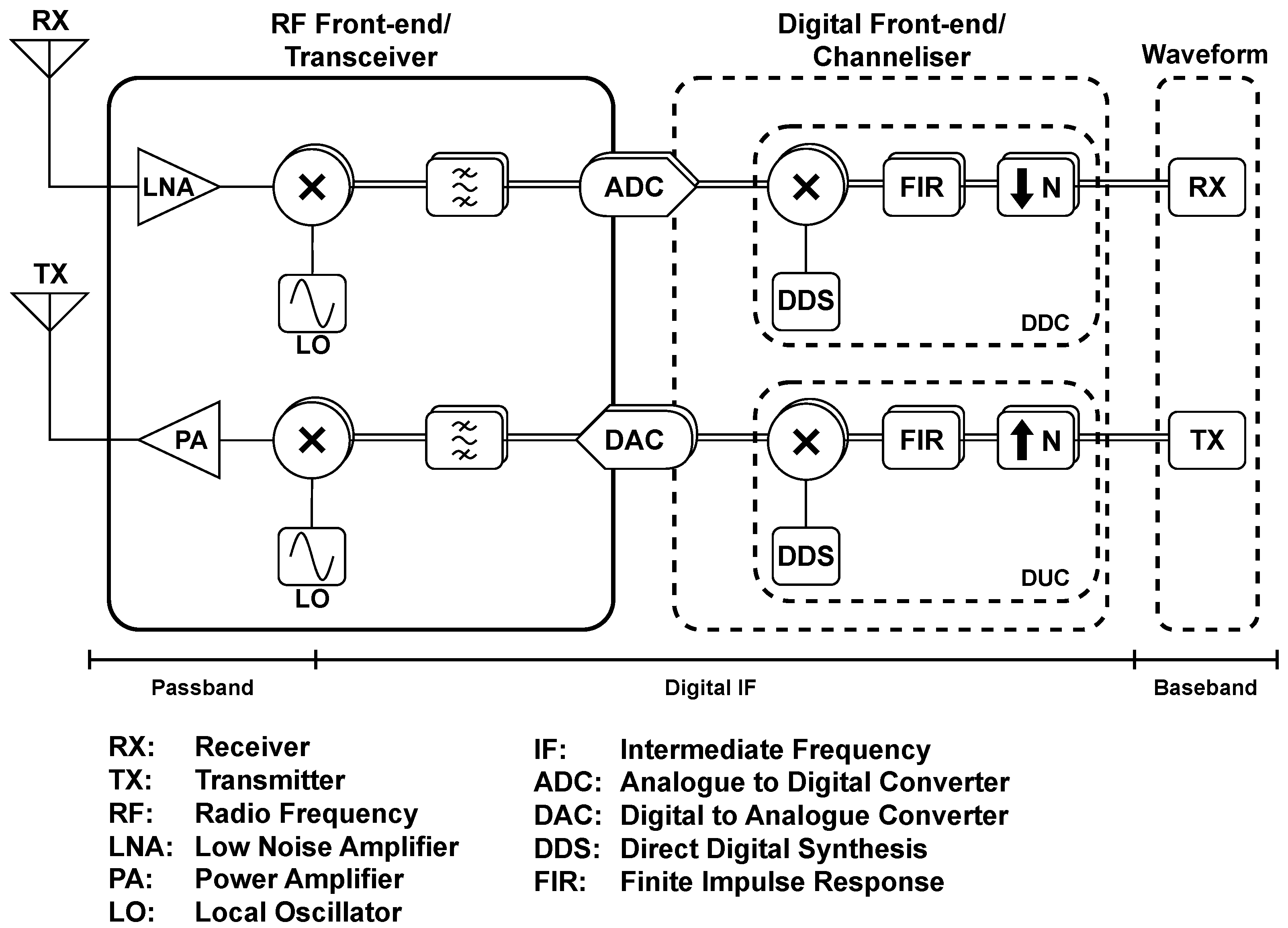

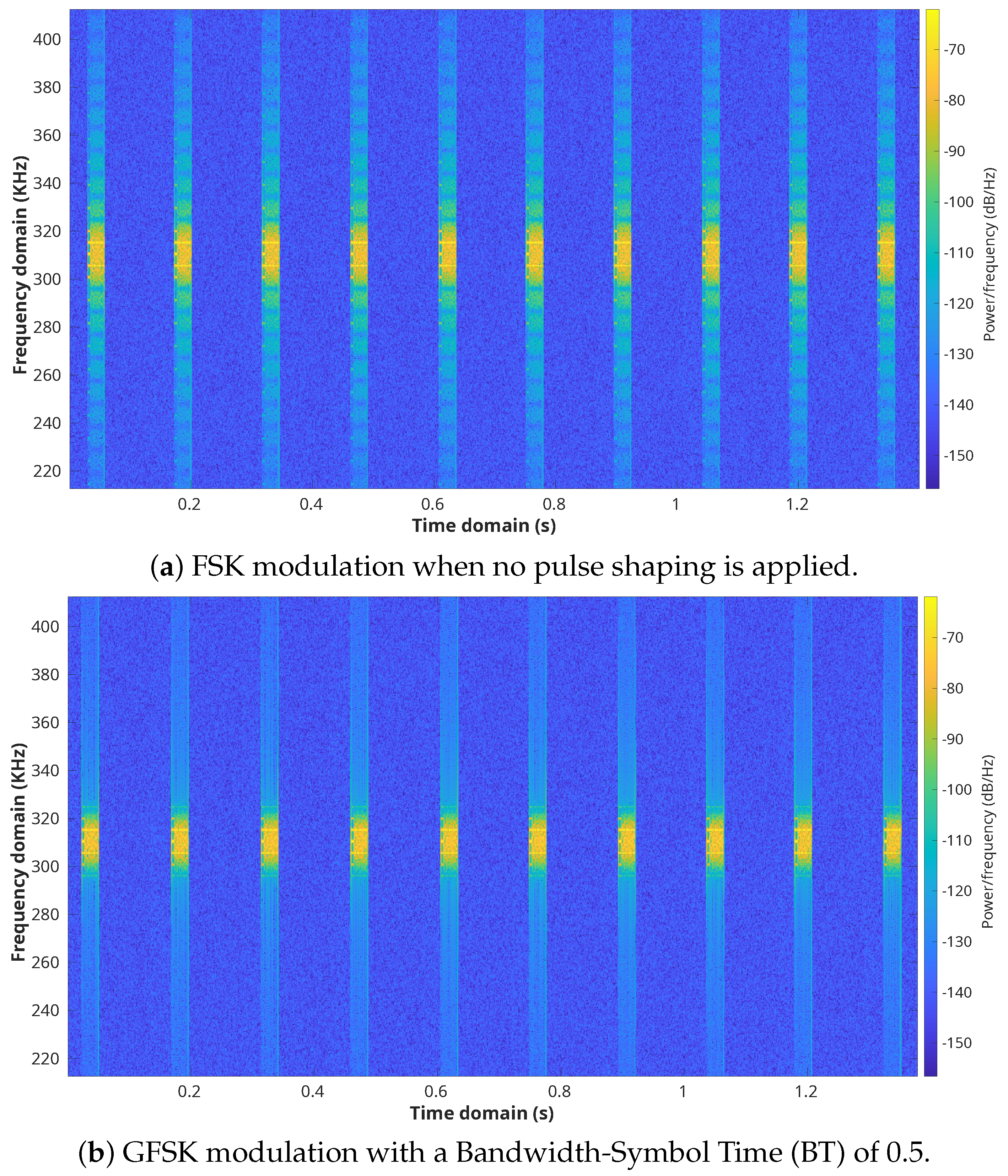
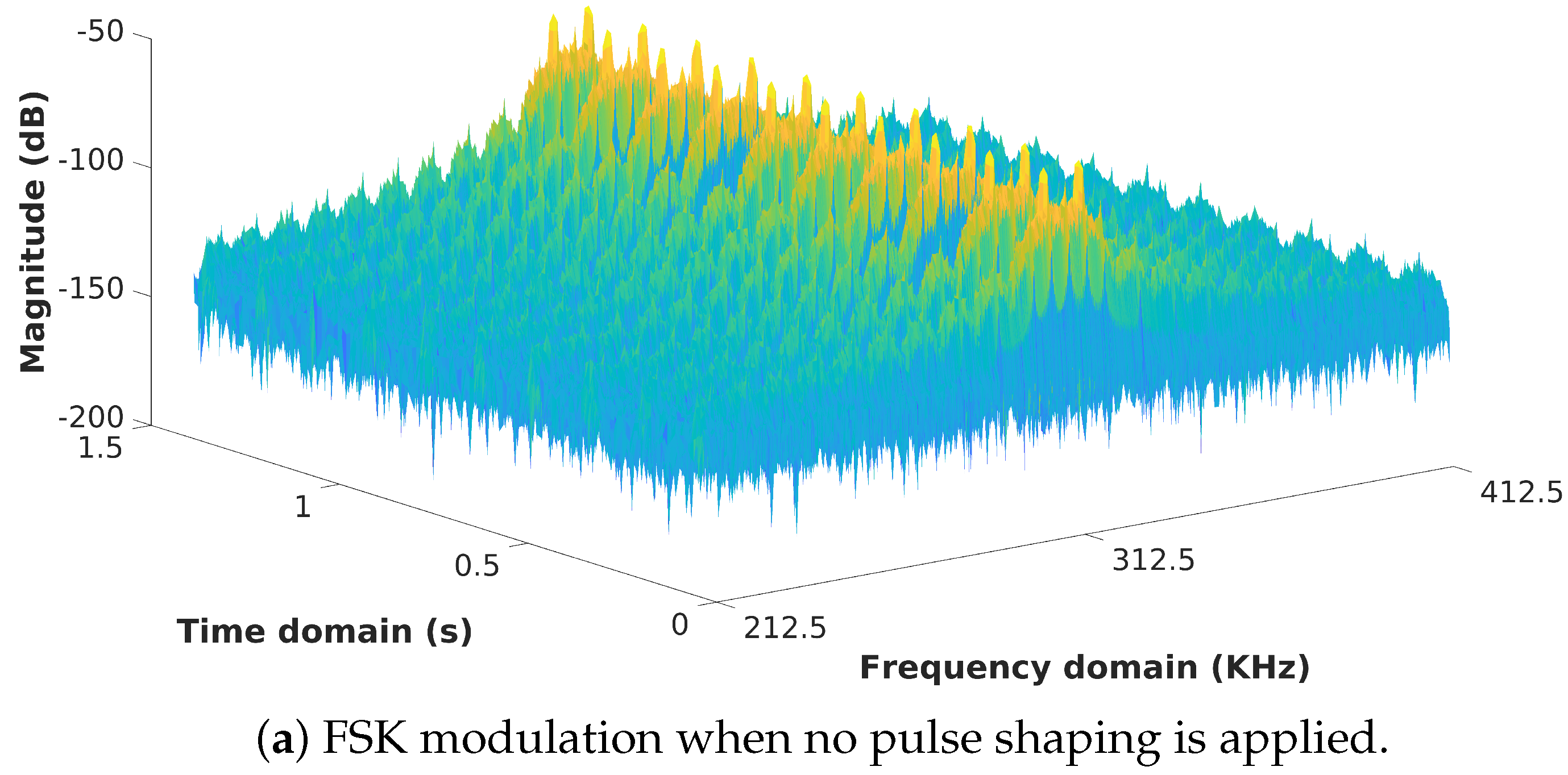



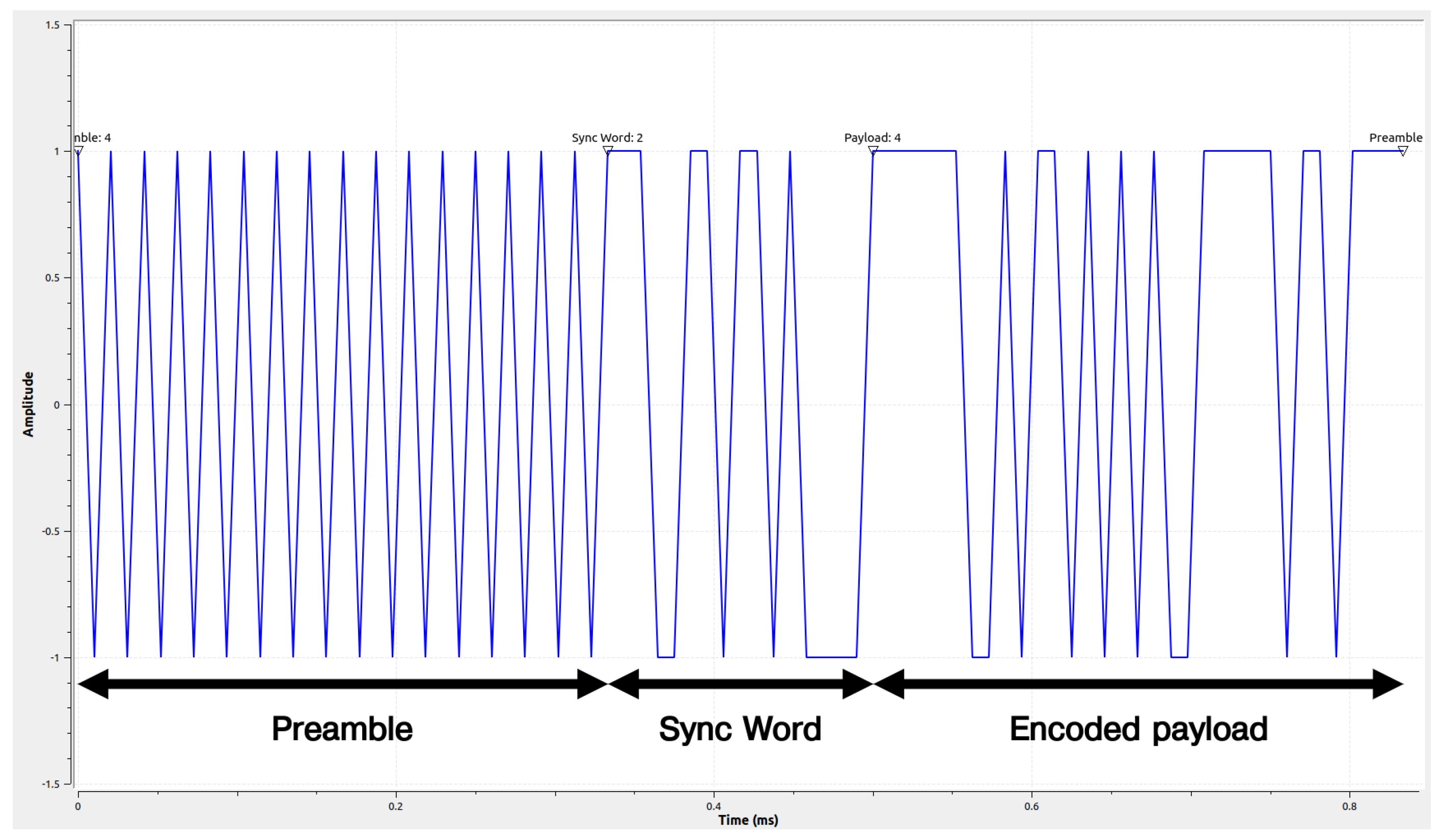

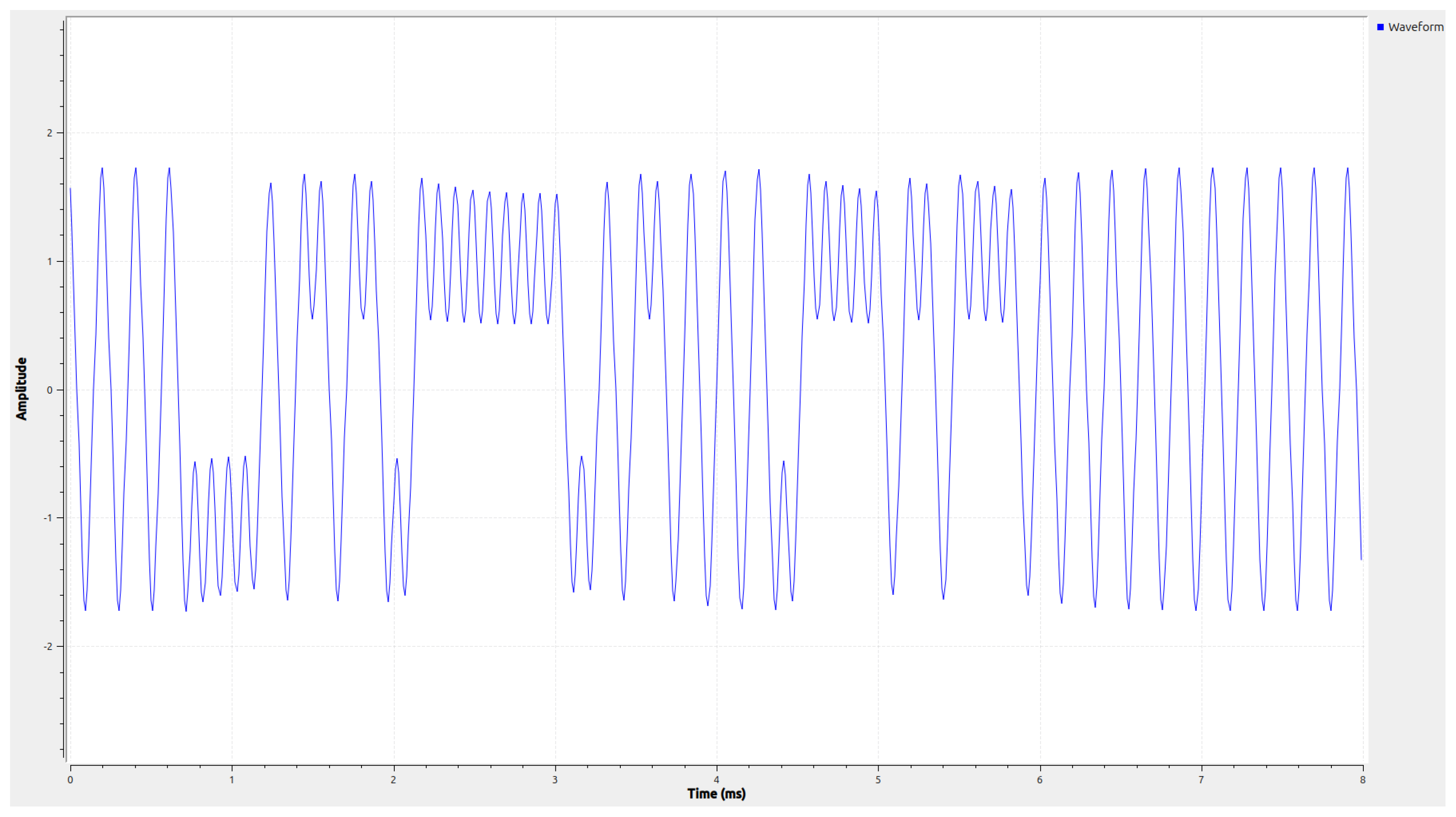

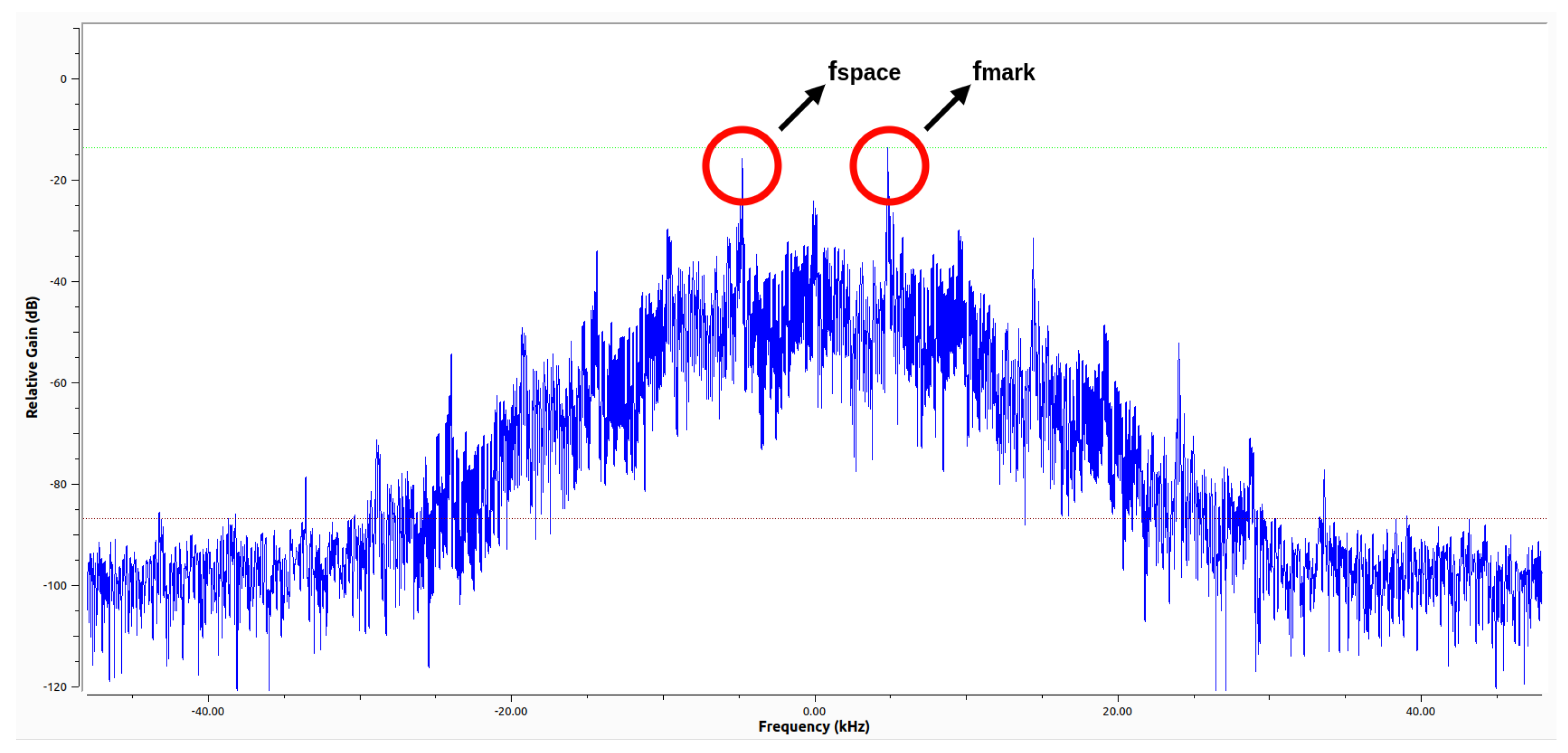

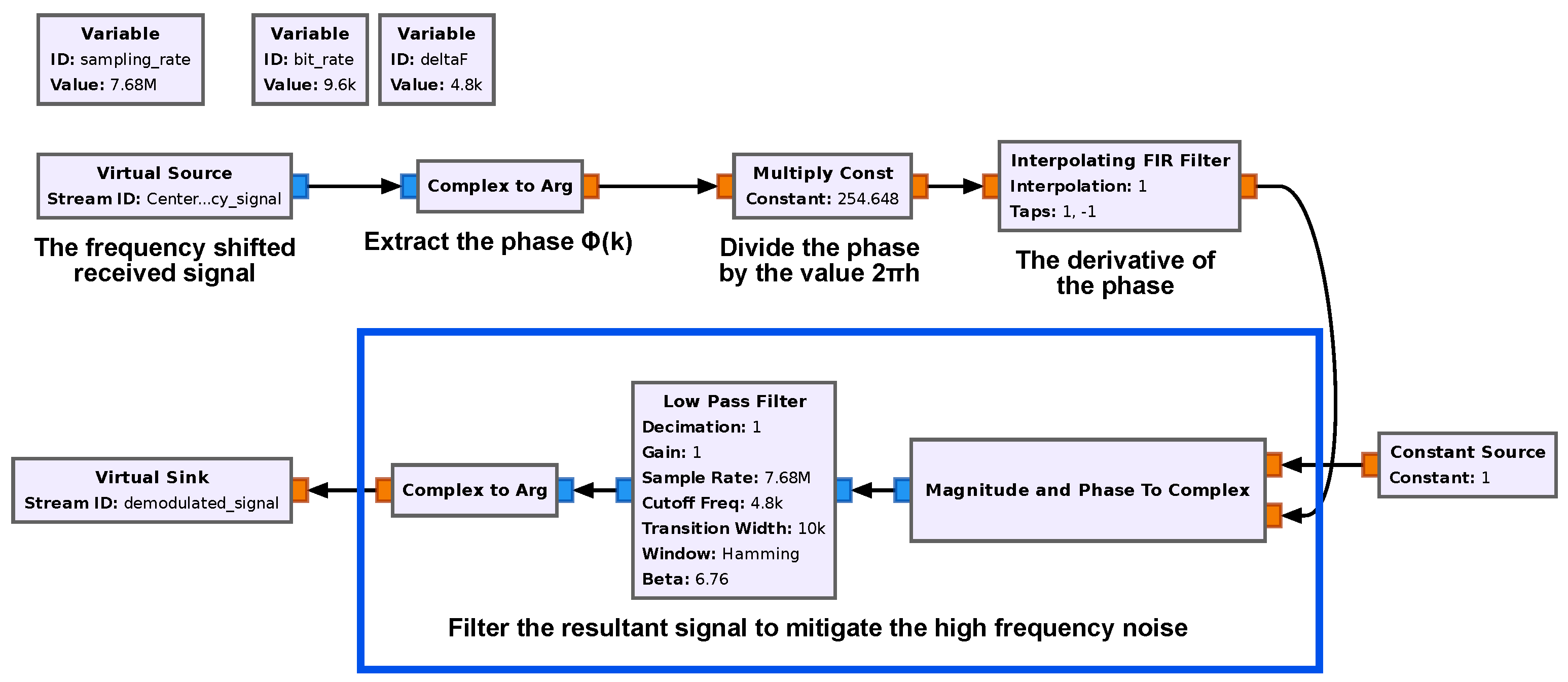

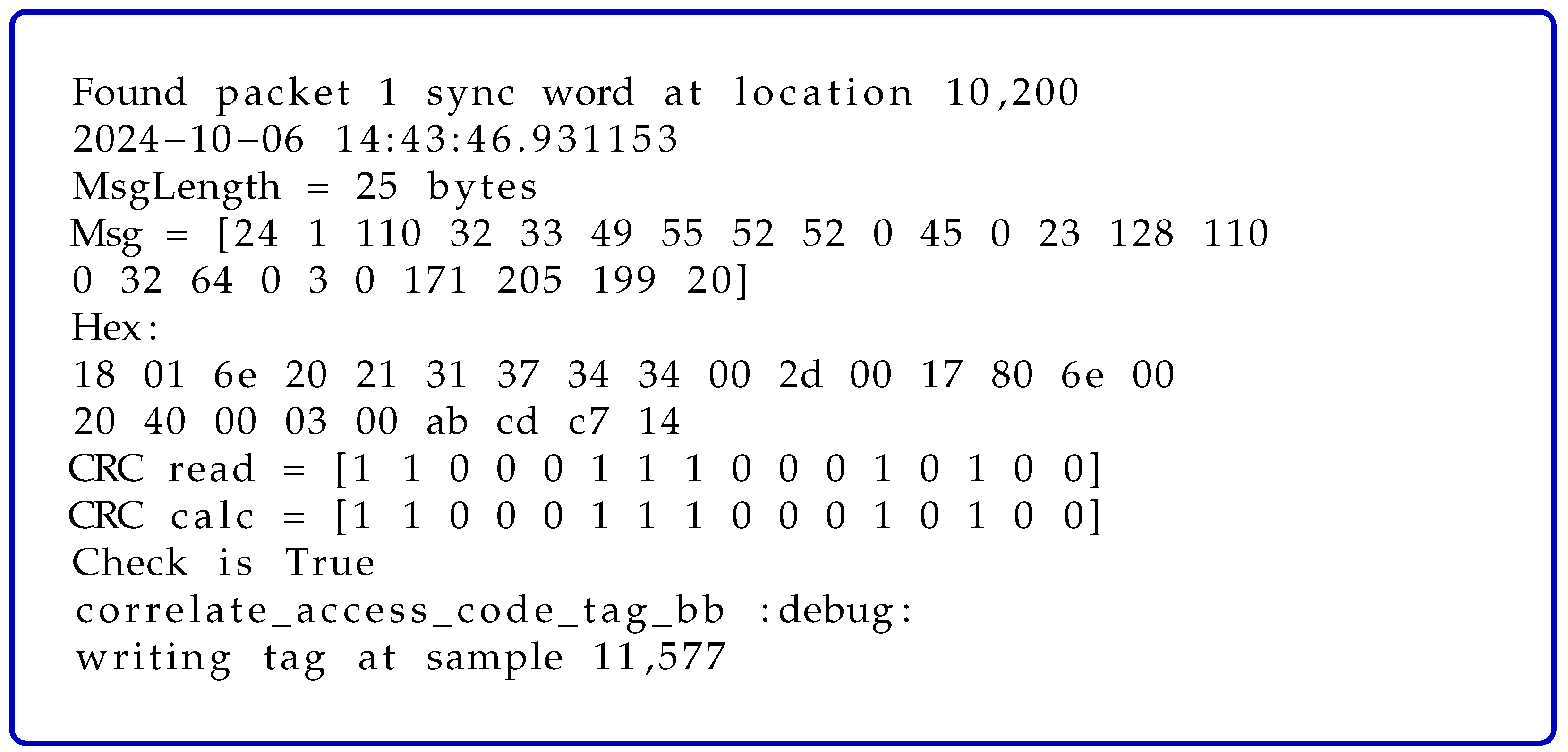

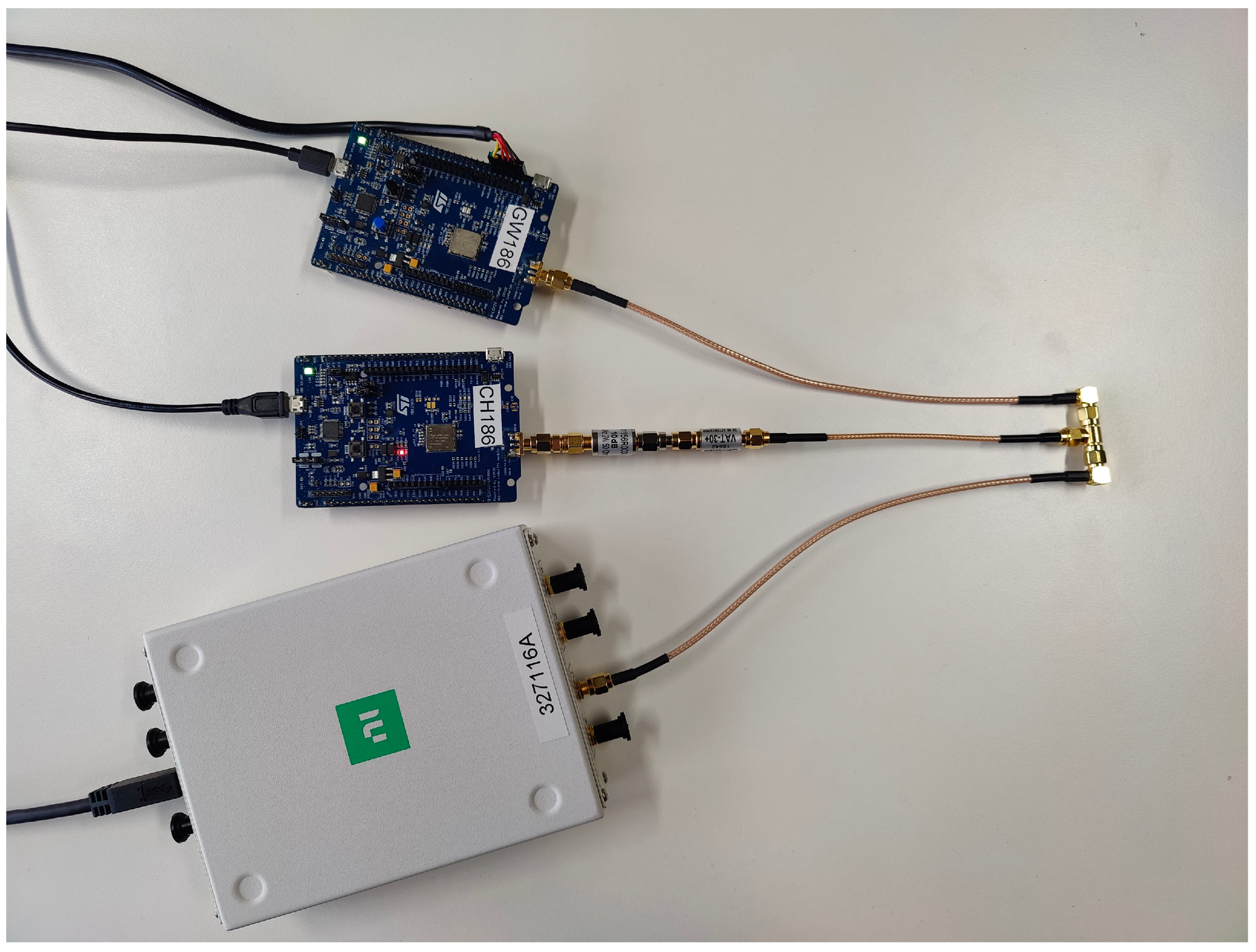
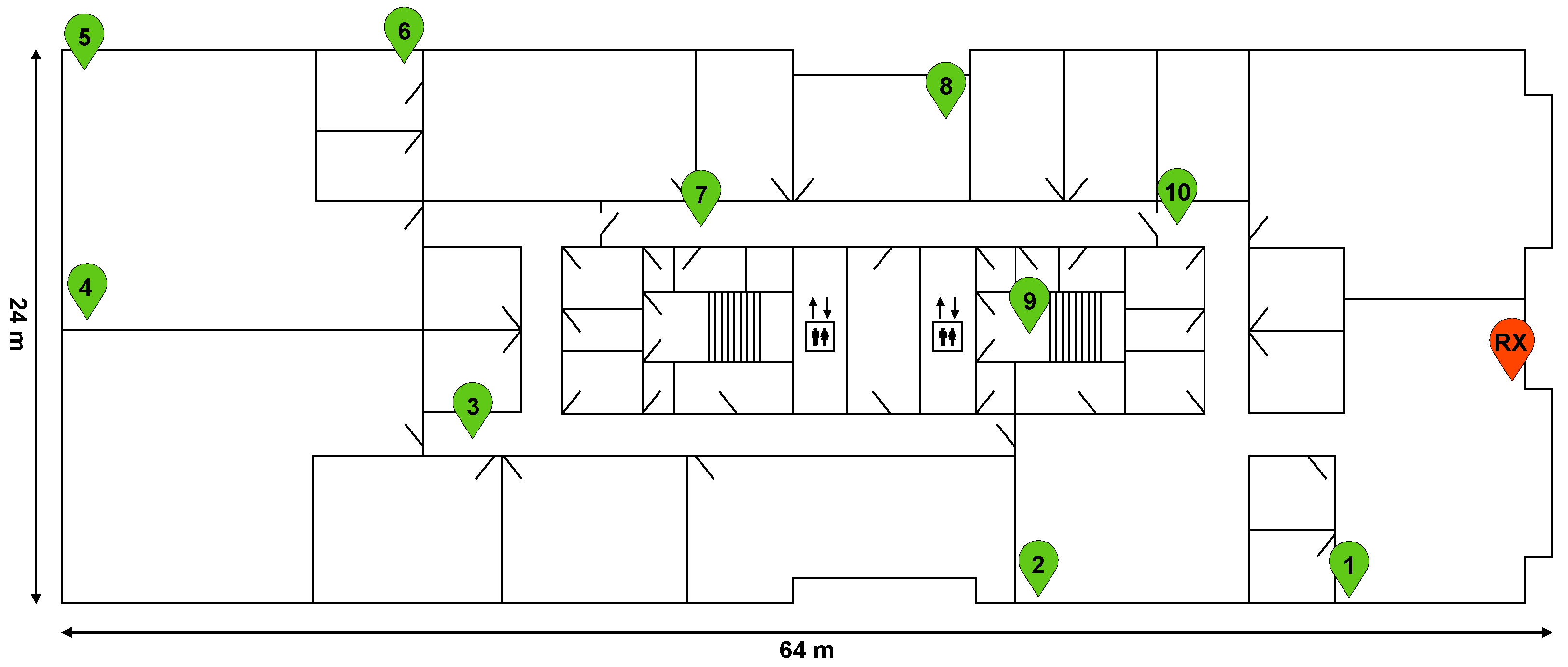

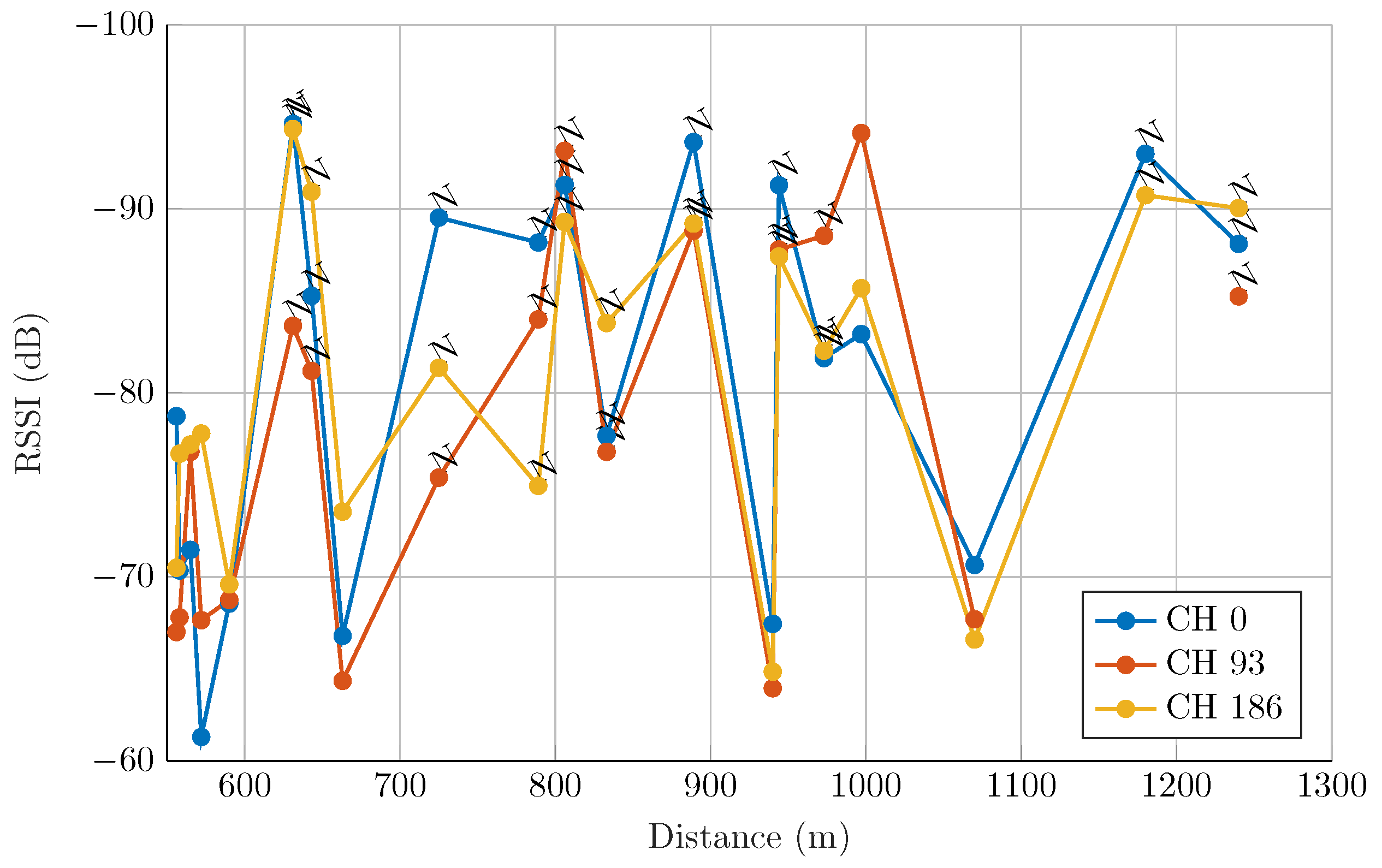


| Operating Frequency (MHz) | Bandwidth (kHz) | Range (km) | Data Rate (kbps) | |
|---|---|---|---|---|
| LoRaWAN | 433/868 (EU) | 125/250/500 | 5 (urban) | 0.3–50 |
| Sub-1 GHz | 915 (US) | 20 (rural) | ||
| LoRaWAN | 2400 | 203/406 | 0.5 (urban) | 0.595–253.91 |
| 2.4 GHz | 812/1625 | 10 (rural) | ||
| Sigfox | 868 (EU) | 0.1 (UL) | 10 (urban) | 0.1 (UL) |
| 915 (US) | 0.1 (DL) | 40 (rural) | 0.6 (DL) | |
| NB-IoT | Licensed | 180 | 1 (urban) | 150 (UL) |
| LTE bands | 10 (rural) | 127 (DL) | ||
| D7AP | 433/868 (EU) | 25/200 | 1–2 (urban) | 9.6/55.6 |
| 915 (US) | 5 (rural) | 166.7 |
| SDR | Frequency (MHz) | ADC/DAC Resolution | Max. RF Bandwidth | RF Channels | Price |
|---|---|---|---|---|---|
| RTL-SDR Blog V3 | 24–1766 | 8-bit | 3.2 MHz | 1 RX | low |
| Great Scott Gadgets HackRF one | 1–6000 | 8-bit | 20 MHz | 1 TX/RX | medium |
| Analog Devices ADALM-PLUTO | 325–3800 | 12-bit | 20 MHz | 1 TX–1 RX | medium |
| Nuand bladeRF 2.0 xA4 | 70–6000 | 12-bit | 56 MHz | 2 TX–2 RX | medium |
| Ettus Research USRP B200mini | 70–6000 | 12-bit | 56 MHz | 1 TX–1 RX | medium |
| Ettus Research USRP B200 | 70–6000 | 12-bit | 56 MHz | 1 TX–1 RX | medium |
| Ettus Research USRP B210 | 70–6000 | 12-bit | 56 MHz | 2 TX–2 RX | high |
| Deepwave Digital AIR7201-B | 300–6000 | 14–16 bit | 100 MHz | 2 TX–2 RX | very high |
| RF Band | Lo-Rate (d) | Normal and Hi-Rate (d) | Start (b) | End |
|---|---|---|---|---|
| 433 MHz * | 0, 1, …, 68 | 0, 8, 16, …, 56 | 433.06 MHz | 434.785 MHz |
| 868 MHz ** | 0, 1, …, 279 | 0, 8, 16, …, 216, 229, 239, 257, 270 | 863 MHz | 870 MHz |
| 915 MHz *** | 0, 1, …, 1039 | 0, 8, 16, …, 1032 | 902 MHz | 928 MHz |
| Class | Symbol Rate | Modulation Index | Frequency Deviation | Channel Spacing (c) |
|---|---|---|---|---|
| Lo-Rate | 9.6 kbps | 1 | ±4.8 kHz | 0.025 MHz |
| Normal | 55.555 kbps | 1.8 | ±50 kHz | 0.2 MHz |
| Hi-Rate | 166.667 kbps | 0.5 | ±41.667 kHz | 0.2 MHz |
| Sync Word Class | Coding Scheme | |||
|---|---|---|---|---|
| CS0 | CS1 | CS2 | CS3 | |
| 0 | 0xE6D0 | RFU | 0xF498 | RFU |
| 1 | 0x0B67 | RFU | 0x192F | RFU |
| CH 0 | CH 93 | CH 186 | |||||||||
|---|---|---|---|---|---|---|---|---|---|---|---|
| Location | GW Mean RSS | GW Packet loss | GRC Packet loss | GW Mean RSS | GW Packet loss | GRC Packet loss | GW Mean RSS | GW Packet loss | GRC Packet loss | Distance | (N)LOS |
| (dB) | (%) | (%) | (dB) | (%) | (%) | (dB) | (%) | (%) | (m) | ||
| 1 | −91.31 | 35 | 50 | −93.16 | 5 | 10 | −89.30 | 0 | 60 | 806 | NLOS |
| 2 | −94.64 | 30 | 30 | −83.65 | 0 | 75 | −94.35 | 0 | 100 | 631 | NLOS |
| 3 | −71.47 | 5 | 0 | −76.80 | 0 | 0 | −77.20 | 0 | 0 | 565 | LOS |
| 4 | −78.74 | 5 | 0 | −67.00 | 0 | 0 | −70.50 | 0 | 0 | 556 | LOS |
| 5 | −70.35 | 5 | 5 | −67.80 | 0 | 0 | −76.70 | 0 | 0 | 558 | LOS |
| 6 | −68.55 | 0 | 0 | −68.75 | 0 | 0 | −69.60 | 0 | 0 | 590 | LOS |
| 7 | −61.30 | 0 | 0 | −67.65 | 0 | 0 | −77.80 | 0 | 0 | 572 | LOS |
| 8 | −85.28 | 10 | 10 | −81.20 | 0 | 5 | −90.94 | 15 | 15 | 643 | NLOS |
| 9 | −66.80 | 0 | 0 | −64.35 | 0 | 0 | −73.55 | 0 | 15 | 663 | LOS |
| 10 | −89.53 | 5 | 0 | −75.40 | 0 | 40 | −81.37 | 5 | 5 | 725 | NLOS |
| 11 | −88.18 | 45 | 0 | −84.00 | 5 | 0 | −74.95 | 0 | 5 | 789 | NLOS |
| 12 | −77.67 | 10 | 10 | −76.80 | 0 | 0 | −83.80 | 0 | 10 | 833 | NLOS |
| 13 | −93.64 | 30 | 80 | −88.82 | 15 | 35 | −89.21 | 5 | 10 | 889 | NLOS |
| 14 | −81.90 | 5 | 10 | −88.55 | 0 | 0 | −82.30 | 0 | 15 | 973 | NLOS |
| 15 | −83.20 | 0 | 0 | −94.13 | 25 | 30 | −85.70 | 0 | 0 | 997 | LOS |
| 16 | −91.29 | 65 | 55 | −87.80 | 0 | 15 | −87.42 | 40 | 25 | 944 | NLOS |
| 17 | −70.65 | 0 | 0 | −67.70 | 0 | 0 | −66.60 | 0 | 0 | 1070 | LOS |
| 18 | −88.11 | 5 | 30 | −85.25 | 0 | 10 | −90.05 | 5 | 50 | 1240 | NLOS |
| 19 | −67.45 | 0 | 0 | −63.95 | 0 | 0 | −64.85 | 0 | 0 | 940 | LOS |
| 20 | −93.00 | 40 | 100 | / | / | 15 | −90.75 | 60 | 75 | 1180 | NLOS |
| 21 | / | 100 | 100 | / | 100 | 100 | / | 100 | 100 | 1260 | NLOS |
| CH 0 | CH 93 | CH 186 | ||||||||
|---|---|---|---|---|---|---|---|---|---|---|
| Location | GW Mean RSS | GW Packet Loss | SDR Packet Loss | GW Mean RSS | GW Packet Loss | SDR Packet Loss | GW Mean RSS | GW Packet Loss | SDR Packet loss | (N)LOS |
| (dB) | (%) | (%) | (dB) | (%) | (%) | (dB) | (%) | (%) | ||
| 1 | −27.45 | 0 | 0 | −22.35 | 0 | 0 | −31.20 | 0 | 0 | LOS |
| 2 | −32.15 | 0 | 0 | −36.59 | 15 | 20 | −40.60 | 0 | 5 | NLOS |
| 3 | −58.70 | 0 | 0 | −60.35 | 0 | 0 | −51.55 | 0 | 0 | NLOS |
| 4 | −92.57 | 30 | 25 | −80.95 | 0 | 0 | −90.39 | 10 | 10 | NLOS |
| 5 | −83.79 | 5 | 0 | −78.45 | 0 | 0 | −89.20 | 0 | 5 | NLOS |
| 6 | −76.80 | 0 | 0 | −76.10 | 0 | 0 | −97.60 | 50 | 5 | NLOS |
| 7 | −67.85 | 0 | 0 | −60.80 | 0 | 0 | −62.50 | 0 | 0 | NLOS |
| 8 | −60.26 | 0 | 0 | −64.79 | 0 | 0 | −64.95 | 0 | 0 | NLOS |
| 9 | −61.84 | 5 | 0 | −66.50 | 0 | 0 | −66.80 | 0 | 0 | NLOS |
| 10 | −58.95 | 0 | 0 | −40.70 | 0 | 0 | −45.00 | 0 | 0 | NLOS |
Disclaimer/Publisher’s Note: The statements, opinions and data contained in all publications are solely those of the individual author(s) and contributor(s) and not of MDPI and/or the editor(s). MDPI and/or the editor(s) disclaim responsibility for any injury to people or property resulting from any ideas, methods, instructions or products referred to in the content. |
© 2024 by the authors. Licensee MDPI, Basel, Switzerland. This article is an open access article distributed under the terms and conditions of the Creative Commons Attribution (CC BY) license (https://creativecommons.org/licenses/by/4.0/).
Share and Cite
Joosens, D.; BniLam, N.; Berkvens, R.; Weyn, M. Software-Defined Radio-Based Internet of Things Communication Systems: An Application for the DASH7 Alliance Protocol. Appl. Sci. 2025, 15, 333. https://doi.org/10.3390/app15010333
Joosens D, BniLam N, Berkvens R, Weyn M. Software-Defined Radio-Based Internet of Things Communication Systems: An Application for the DASH7 Alliance Protocol. Applied Sciences. 2025; 15(1):333. https://doi.org/10.3390/app15010333
Chicago/Turabian StyleJoosens, Dennis, Noori BniLam, Rafael Berkvens, and Maarten Weyn. 2025. "Software-Defined Radio-Based Internet of Things Communication Systems: An Application for the DASH7 Alliance Protocol" Applied Sciences 15, no. 1: 333. https://doi.org/10.3390/app15010333
APA StyleJoosens, D., BniLam, N., Berkvens, R., & Weyn, M. (2025). Software-Defined Radio-Based Internet of Things Communication Systems: An Application for the DASH7 Alliance Protocol. Applied Sciences, 15(1), 333. https://doi.org/10.3390/app15010333








